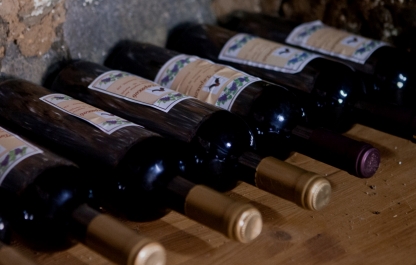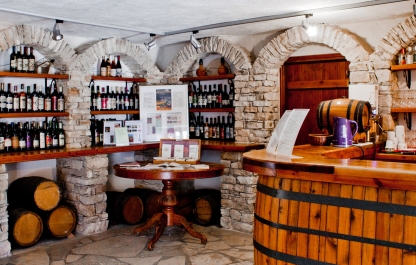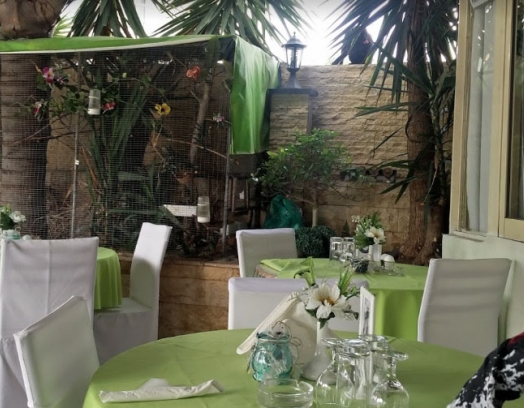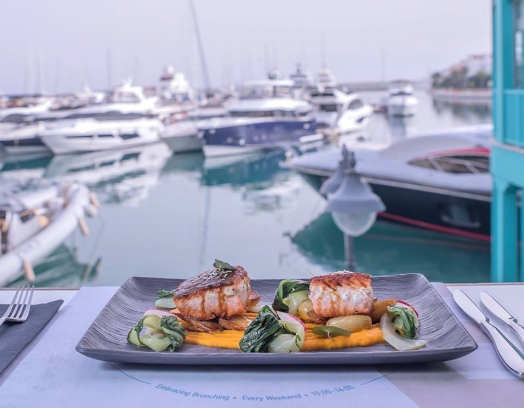Along with numerous authentic dishes, there is, of course, a large selection of the most varied drinks in Cyprus: some of them have “survived” to our time through the centuries. The concoctions Cypriots once used to produce in their homes have achieved industrial-scale production levels today, and the same widespread popularity. Thanks to tourism, which has contributed to growth in production, tens of thousands of visitors visit the island and get acquainted with its delicacies, an important element of which is the drinks
Moreover, in our time, the island inhabitants understand the significance of these drinks being present in the modern diet, both as a valued item inherited from their ancestors and an inherent part of folk culture.
Therefore, nowadays, the idea of preserving authentic Cypriot gastronomy is a priority task, as they say, on all levels.
At the end of this article, you will find several links to sites which support and promote Cypriot cuisine, as well as ones where you can buy many of the drinks that we shall discuss today.
Those of you who are especially passionate and patient can expect a few surprises from us: several decent cocktail recipes.
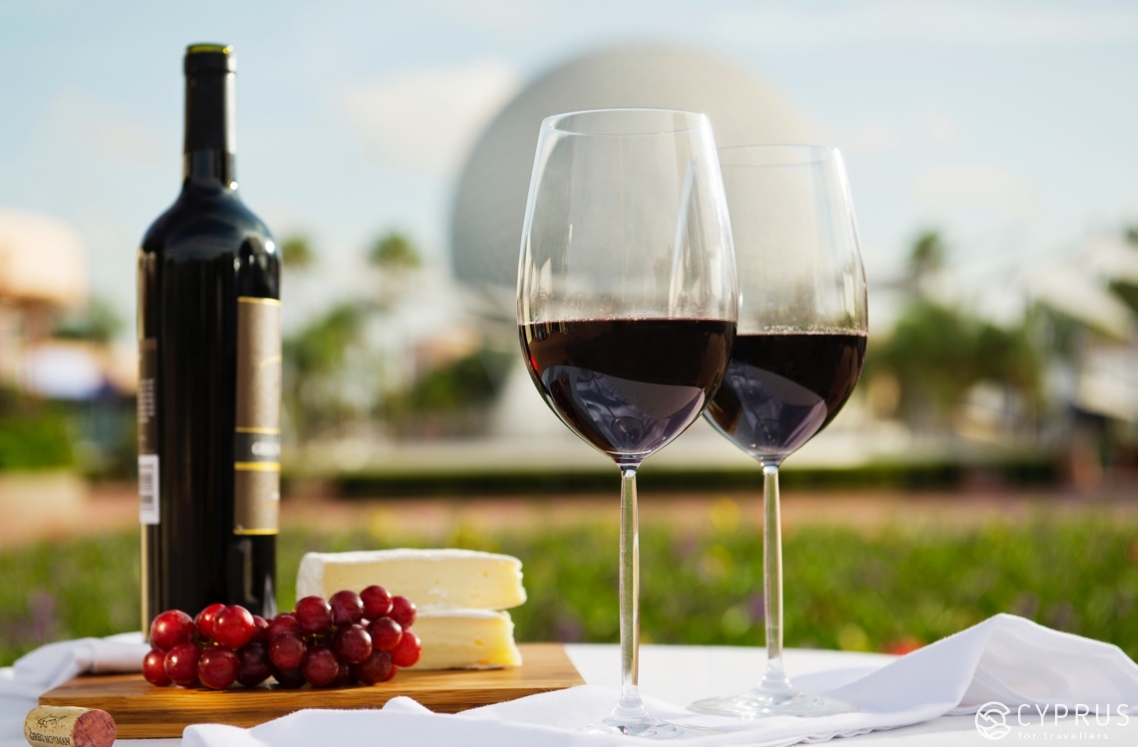
So, our "journey" has two predictable ports of call: alcoholic and non-alcoholic drinks.
The island’s ancient wine-making tradition spans over several millennia; therefore Cyprus may well be a contender to bear the honorary "title" of the birthplace of the oldest wine in the world — one which is still produced here. Naturally, we are talking about the “queen of wines”, the famous Commandaria. No less famous is zivania, the “fiery” drink that has been distilled for so many generations using the remaining grape pulp from wine manufacture.
In any tiny village, not to mention modern cities and towns, you will definitely have the opportunity to enjoy the most flavoursome traditional Cypriot coffee. There will also be a chance to simply contemplate your surroundings and the leisurely course of the day’s events while relaxing and sipping on a frappe — a ubiquitous cold coffee drink, which has become both a token “accessory” for foreigners and even a “sign” of a true Cypriot, accompanying them in almost any situation.
And so we have named you “three whales” from the ocean of national Cypriot drinks …
Heard a lot about them but haven’t tried them even once, you say? Do you still think you know enough about the drinks on this island? Well, whether that’s the case or not — we shall now see ...
Let us, perhaps, start with drinks we’ve known since the deep antiquity thanks to their exceptional taste, as well as their benefits which have long been noted and appreciated. We can testify to this with ancient scholar tractates and travellers’ diaries which have survived to our time.
As a matter of fact, the Cypriots can trace their gastronomic heritage (dishes and drinks, customs and eating culture) rather far into the past — it stands today as a product of the food eaten since long ago by the indigenous people. The local cuisine is not just a variety of dishes which have arisen in the framework of local traditions; its appearance and formation have been significantly influenced by introduced and assimilated elements. These elements further spread and even acquired special “rules of use”, thanks to tendencies adopted from foreigners or the manners and customs imposed by certain rulers.
Need I remind you that in the course of its long and very turbulent history, as well as owing to the peculiarities of the island’s location in the Eastern Mediterranean, Cyprus has been a famous allegory of a multicultural and inter-civilisational “crossroads”. This intersection is split between three continents and a whole host of completely different nations that have made their mark over the centuries!
And yet, the most important factors are the following:
- The long, deep-rooted Greek civilisation, a culture dominated by national diet and two “pillars” of Hellenistic catering: taverns and mezze;
- Many foreign rulers (Venetians, Franks, descendants of Arab invaders, Ottoman Turks) brought their own eating habits and processing methods, which were gradually assimilated and subsequently became a part of the local gastronomy;
- A favourable climate, which for centuries has allowed the population to produce a variety of highly nutritious natural products;
- As for drinks specifically: the island’s long history, reflected in the rich and ancient practice of cultivating vineyards and producing wines.
In the present day, traditions linked with food and drinks testify to the unique abilities of the Cypriot people to use the gifts of their native land in their national culinary culture.
Today, products which are characteristic of the Mediterranean and have originated here are widely acknowledged as an excellent choice for gourmets. This nigh on exemplifies the most balanced cuisine (especially the so-called "Greek diet") and is a superb choice for leaders of a healthy lifestyle.
The products, dishes and food tradition on the island are the cornerstones of this diet, combining magnificent tastes and a handful of components which are both healthy and beneficial to strengthening the body.
Moreover, the apologists of the "cousin of Cypriaki" (η κυπριακή κουζίνα, also, Cypriot cuisine) confirm the above with their love for citing the results of various scientific studies: for instance, a recent edition of the journal of the American Medical Association notes the particular benefit of a Mediterranean-style diet for maintaining human health. Research showed that completely adhering to Mediterranean “ideals” of nutrition contributes to an improvement in overall performance, maintaining longevity, and also preventing the development of so-called metabolic syndromes (a condition characterised by obesity and high blood pressure).
Thus, today, it is no coincidence that the following task has been set in the Republic of Cyprus at a state level: a higher number of authentic Cypriot food products are to receive official protection under EU rules. This will achieve PDO (protected designation of origin) and PGI (protected geographical indication).
How is this being implemented? In conditions of globalisation, local manufacturers have pledged to provide the market with the highest quality products, using only natural raw materials, variations of innovative packaging and a diverse assortment of recipes to satisfy contemporary market demands.
So, here you have:
Chapter One: Alcohol Native to the Island of Aphrodite
The island's local grape varieties are some of the oldest in the world. At the same time, Commandaria — the sweet dessert wine — is, in turn, the oldest titled wine, and one still in production today.
In the present day, the winemaking tradition is experiencing a new surge. It has fallen into the eye of tourists, with the CTO organisation developing seven wine routes on the island (see here for more detail). As it was in the past, all current winemaker villages produce both red and white wines (see our “Wine Journey").
As for alcohol on industrial and amateur levels, you can simply follow the link to our article. It will provide you with more detailed information and recommendations to help you choose, as well as information about zivania. When you visit any wine boutique or supermarket, you will feel well-versed and equipped to make the right choice — be it based on your guests’ personal preferences, the dishes in your future feast, snacks for friendly get-togethers, and of course, based on your budget.
We’re going to speak about them in more detail today. That is, we’re going to savour the details and get to grips with what's customary to drink in Cyprus. Besides, we shall discuss how much to drink, in what combination, and, most importantly, when and the reasons for this ...
Naturally, like with any other aspect of Cypriot life, this topic is linked to stories and habits — all densely shrouded in the traditions of many generations.
From the simple to the complex ...
Beer
Beer is one of the most popular drinks in Cyprus and likely of prehistoric origin. The art of brewing — a process that came to us from the remote antiquity — has been known to man practically since the dawn of civilisation, immediately beginning, according to sources from Sumer and Mesopotamia, with the cultivation of barley in 6,000 B.C.
The following have always been key ingredients in brewing: namely water, hops, barley malt, maize, rice or sugar, and yeast occasionally supplemented with corn.
Despite the great successes observed to date in methods for achieving high-quality production, beer is still a drink made from natural products.
In addition to the above, brewers will tell you that one batch of beer requires around 30 days to be produced. The brewing process itself takes nine and a half hours, while fermentation and ageing take a combined 21 to 35 days for ale and a little longer for lagers.
As it is closely tied to Greek civilisation, Cyprus, like Hellas, has a brief history of beer consumption. Historical references to the production and consumption of beer in the antiquity are practically non-existent, and it can be fully assumed that the drink was introduced for general use in Cyprus only at the end of the 19th century: in the first years of British colonisation.
Historians of this topic pedantically elaborate how this happened with the first batch on the ship “Thessaly”, which arrived in Cyprus after the British seized the vessel from the Turks in 1878. 50 barrels of beer were on board.
Another reason why beer wasn’t widespread on the island for a long time concerns the island’s issue with fresh water: in former times, the seasonally limited resources of soft water weren’t able to provide the fundamental raw materials for beer production. This was unlike the geographical and climate conditions characteristic of countries in continental Europe.
In the 1930s and 1940s, the Cypriot market consumed no more than 500 thousand litres of beer, mainly imported from Europe; only a small amount was supplied by small local producers.
Available information gives testament to the fact that “Leonbeer” was a product of the first commercial brewery in Cyprus, founded in 1937 by H. Platanis in Nicosia.
Over several years, the M. Platanis & Co Ltd brand has remained the only “large” beer manufacturer in Cyprus.
In 1962, P. Photiades joined the board of the company, a move which saw a change in the brand’s name — until 1968, Cypriot beer was brewed under the brand name Photos Photiades Breweries Ltd. Later, the company obtained licensing to manufacture Carlsberg on the island, resulting in Cyprus being the first country in the world to begin producing Carlsberg outside of Denmark.
As for the Cypriot brand, Leon beer was launched by the company for a second time in 2003, again manufactured at the factory of Photos Photiades Breweries Ltd. This time, it was met with great success.
Another large Cypriot brewing company, KEO (Kypriaki Etairia Oinopnevmatodon), was founded in 1927 for the manufacture of alcohol (wines) and other drinks.
Specialists from the Czech Republic took part in the construction of the brewing section, which was launched in 1951. Modern beer from KEO is a type of light pilsner which won popularity amongst both Cypriots and tourists thanks to its light, refreshing effect. It is best suited for drinking cold, especially in the hot summer months.
Thus, production from local brewers constitutes close to 90% of annual consumption, with the remaining 10% made up of imported sorts. Also, only 3.5% of all beer produced totals the share of exported beers.
Local Wines
We’re going to talk about wines, brandy and other types of alcohols, as well as well-known cocktails and blends. In fact, to find out what is drunk in the bars, cafes and restaurants of Cyprus, as well as what accompanies these drinks, please see some recommendations, criticisms and reviews from the blog of Cypriotandproud, a famous expert (a highly valuable and recommended resource).
And so, repeating what we’ve been over
The two primary sorts of local grape are Mavro and Ksinisteri. Ksinisteri, amongst other things, is the most common sort of white grape, used to produce pale, light wines with low alcohol content (11-11.5%). The Mavro (black, red) is large and delicious, used to make red wines which are slightly opaque in colour, also possessing a light flavour.
When both sorts are mixed, commandaria is produced from their basic ingredients, and the remainder of the raw material (pulp) is used to create the “national” spirit zivania.
Maratheftiko and Opthalmo are two other local sorts — both red — which have been known since the antiquity. Alongside them, some foreign grape sorts are also grown on the island, including Chardonnay, Alexandrian Muscat, Palomino, Riesling, Sauvignon Blanc and Sémillon — white sorts. There are also red grapes such as Alicante Bouschet, Cabernet-Fran and Cabernet Sauvignon, Senso, Grenache Noir, Mataro and Shiraz.

Like everywhere, local wine produced in the summer is more often drunk at a slightly chilled temperature and served with appropriate appetisers or stand-alone main meals.
For those wanting to indulge in the local winter wines, aside from the widely acknowledged recommendations, we would suggest you don’t glance over the opportunity to warm yourself with the local version of glint vein.
For how to do this like a proper Cypriot, please read here.
Brandy
Cypriot brandy in itself is rather light, with an alcohol content of around 32% and a slightly sweet aftertaste.
Rather long ago, the local residents elevated this distillation product, combined with other locally originating ingredients, to the almost rank of national cocktail — a mixture of Cypriot brandy, undiluted lemon squash, a few drops of angostura (a strong liqueur, concentrated bitter) and the addition of sparkling water.
A commonly accepted legend tells that this cocktail was first concocted at the Forest Park Hotel in Platres, in the late 1930s. It was sampled to King Farouk I (1920-1965), the young ruler of Egypt and Sudan at the time, who often stayed at the hotel during his frequent visits to the island. What’s more, few people are aware of why the bartender even decided on this invention.
It is not known for certain, but the legend conveys to us the following: King Farouk was not only a great sybarite but also a fan of alcohol. However, being the ruler of a Muslim country, he could not appear before his subjects drinking anything strong.
And so, the hotel management seemingly tried to assist him, proposing the following plan for their highest-ranking guest: the monarch would enjoy his cocktail, looking as though he were sipping iced tea.
The trick, it would seem, was a success, but secrets in Cyprus don’t remain secrets for long, and the details of this one came flowing out soon after.
Everyone started talking about the cocktail and began to order this newfound concoction all over the island. It very quickly became a favourite of both the locals and foreigners who flooded the island, especially in the hot summer months.
Following on in the footsteps of the Eastern King…
Brandy Sour Recipe
To make a cocktail based on KEO’s Cypriot brandy “Five Kings” stick to this exact recipe using the following ingredients:
- 1 or 2 parts Cypriot brandy, depending on your taste preferences,
- 1 part lemon squash (to your liking),
- Several drops of angostura bitters,
- Soda or lemonade,
- Ice cubes
- A slice of lemon for decoration
Preparation:
Pour some brandy into a glass, add lemon squash, angostura bitter, then sparkling water or lemonade. Place ice cubes on top and a slice of lemon as a finishing touch.
To our health! (Γεια μας!)

Commandaria
Another personage of royal blood made note of his stay on the island and his great interest in its alcohol.
King Richard the Lionheart, while once enjoying this sweet dessert wine, proclaimed commandaria, whose name rose from the crusaders of the 12th century, the true "wine of kings and the king of wines".
The drink emerged from the ancient drink Nama — a red wine which was widely produced and consumed in Cyprus and Greece in ancient times, up to the 12th century; nowadays, it is used in church Communion. Now cloaked in history, as well as the recognition of many generations and whole people from bygone nations, commandaria is the oldest wine in the world and one you can easily get hold of.
The wine is left to mature for 2-4 years.
Commandaria is made from the slightly sun-dried local grapes Ksinisteri and Mavro. Also, as you know, this sweet dessert wine wasn’t only acknowledged by ancient rulers, knights and travellers — commandaria is still loved by both amateurs and connoisseurs all over the world.
It is customary to serve at the end of dinner. The wine’s flavour best manifests in combination with good, strong-tasting varieties of cheese and fresh fruit.
Commandaria is usually served chilled (up to 6-9°C) in a low glass, with the walls tilted inward to preserve and reveal its vibrant bouquet.
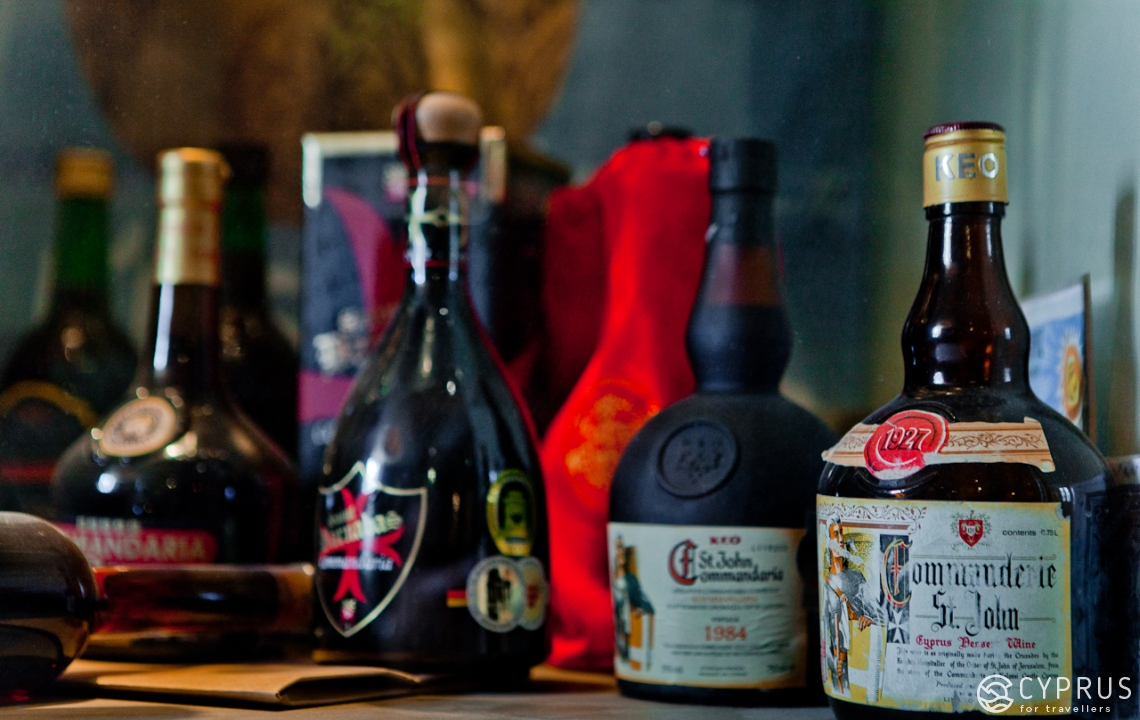
Vodka and Liqueurs
From the deep antiquity until the recent present, every house on the island was capable of making liqueurs and strong, wine-based homebrews, as well as fruit and berry concoctions with, of course, the use of various spices.
Here’s something else you can encounter and gladly try today…
Zivania
Also known as the island’s “fiery water”, with a 40-90% alcohol content, it is the product of distilling wine and the grape pulp remaining from the wine-making process.
As is said by the locals, who are proud of this drink — a few mouthfuls of zivania will make you feel like you’re on top of the world!
Fancy trying some?
Zivania used to be consumed as an aperitif: at the end of a long day working in the fields, mines or factories, weary men would often come home and knock back a shot or two.
Nowadays, the majority of facilities which manufacture zivania are state-regulated, though they are still fewer in number than in past decades.
At the same time, many villagers still make home-brews in the courtyards of their homes, with the population of various mountain hamlets having a particularly active involvement in this process — this is where the drink’s strength can go through the roof!
In our day, on the other hand, you have a choice: do you want to buy a bottle of something strong in a supermarket, or, would you prefer to immediately combine several bonuses of your stay in Cyrpus by heading out to the villages. Many of them will familiarise you with the manufacturing process — to taste and purchase the local food and drinks.
The appearance of this strong drink dates back to the 14th century when the island was under Venetian rule and is still manufactured using almost the same old technology.
Distillation takes place in a cauldron over three different cycles, resulting in several batches of the drink with varying qualities and strengths. It is either colourless or “red” with the addition of other ingredients (cinnamon), but is always transparent.
Over time, “red” zivania only becomes better and more fragrant, so an old bottle is often preserved solely for special events.
And a local trick: before the emergence and distribution of drugs used in modern medicine, zivania was the primary first-aid tool in every Cypriot home.
Another note: zivania is usually served with mezze, nuts (almond or walnuts), sudzhuko (for those not up to date: this is a local sweet, similar to the Georgian churchkhela, well-known to our Russian readers) and slices of beef jerky.
Bear in mind also: zivania is best served cold — straight from the deep-freeze.
In other cases — it’s still a lifeline if you’ve no other healing agents at home. Cypriots use it today to treat and disinfect wounds and perform healing massages on numbed body parts. It is also a mouthwash for sharp tooth pain, and generally a balm to be rubbed on people with a cold.
This is of particular importance for the mountainous villages of the Troodos, where the air temperature falls much further below zero than in coastal areas.
In fact, one of our journeys through the mountainous villages of the Pitsilia region actually landed us in the village of Platanistasa, where, with the assistance of the locals, we got carried away immersing ourselves in the production process: see here.

Ouzo — (Greek ούζο) — a dry, aniseed aperitif manufactured in Cyprus and Greece. It was predictably adopted from the Turkish word üzüm meaning “grape” (nevertheless, some specialists believe its name derived from the Italian language).
Ouzo is very common in Greece, Cyprus, Lebanon and Israel. To connoisseurs, its taste resembles other famous aniseed vodkas and liqueurs such as rakia, pastis and sambuca.
Ouzo traces its roots back to Tzipuro — another alcoholic drink favoured by the Greeks (if you’ve heard about the first three instances, then we’ll tell you about this one: it’s a fruit distillate from the same line, 40-45% in strength). It is believed to have first appeared thanks to an invention by a group of 14th-century monks on Mount Athos.
So, according to one version, the obtained drink was sometimes flavoured with aniseed — over time, this type of Tzipuro became known as ouzo.
Modern distillation of the drink relates largely to the early 19th century after Greece gained independence in 1820. Besides, the first world distiller of ouzo was founded in 1856 by Nikolaos Katsaros, a native to Tyrnavos.
An interesting fact: in the early twentieth century, when the famous absinthe fell into disgrace in Europe [1], ouzo witnessed an inconceivable rise in popularity, thus filling the gap; — it was then that it began to be called “an indisputable replacement for absinthe” [2].
In 1932, owners of factories which manufactured ouzo developed a distillation method using copper distillation cubes — the standard production method in the present day.
On the 25th of October 2006, Greece gained the right to label ouzo as an exclusively Greek product. Since then, the EU has acknowledged this drink, as well as some other Greek alcoholic drinks (tsipouro and tsikoudia) as a product with a protected designation of origin. Thus, only the manufacturers of Greece and Cyprus are entitled to use this name.
The star anise added during production is sometimes accompanied by other flavourings such as fennel, mastic, cardamom, coriander, allspice and cinnamon.
The flavours and their exact combinations are a factory secret.
Afterwards, following several hours of distillation, a flavoured distillate is obtained with an alcohol content roughly 80% of the entire volume. Although the first and last batches are discarded to avoid weak and strong alcohols, as well as the build-up of flavouring residue, they are put into production again, mixed together and subjected to a “secondary” distillation. The quality of this product is different from the original ouzo: with a minimum alcohol content of below 37.5°C.
In rural and urban cafe-restaurants in Cyprus and Greece, ouzo is served at the beginning of the evening with “fish” meze (des) appetisers: octopus, sardines, calamari, shellfish, as well as salad, fried courgette, french fries, olives and feta cheese.
It is traditionally drunk slowly and in small sips, most often mixed beforehand with water (50/50), which turns the transparent liquid into a pearly, translucent colour. This is because anethole, the essential oil of the aniseed, is completely soluble in alcohol — beginning at 38% and higher — but not in water.
Sugar can be added before diluting the liquid, something which is mainly done when serving ouzo from southern Greece.
In other countries, it is customary to order and drink ouzo in authentic Greek restaurants as an aperitif: it is served in a glass and deeply chilled before people begin dining. Ouzo isn’t diluted here, but the degree of cooling is much higher than in the Mediterranean: with the formation of ice crystals.
The main trick to drinking ouzo is to not let the alcohol suddenly “smack you in the head” shortly after drinking — due to the sugar content in the alcohol, you need to continually wash it down with food ... and preferably “something a little fatty”.
Curiously, although ouzo isn’t used, as a rule, in traditional cocktails, it is the base for Ouzini, a fashionable cocktail on the island in particular.
The drink came into circulation thanks to Michael Paraskos — an English Cypriot and native to London (born in 1969). It is also associated with the work of this famous, contemporary novelist.
In his novel “In Search of Sixpence”, the recipe for an ouzo-based drink with orange juice was first described. It became a worthy and more modern alternative to the national and nowadays, ubiquitous, Brandy Sour cocktail.
It is now also called the "Greek Tiger", and you can try mixing the cocktail yourself:
- 1 part aniseed vodka,
- 4 parts orange juice,
- Ice cubes,
- A little lemon juice and a slice of lemon as a finishing touch.
Method:
Mix ouzo with orange juice. Add 4 ice cubes and mix thoroughly in a shaker.
The cocktail ought to be served in an Old Fashion glass, with a few drops of lemon juice squeezed on top and a slice of lemon to decorate the glass.
According to Paraskos, the proper drink should somewhat resemble the taste of “liquid anise balls”, referring to the traditional sweet boiled in syrup “on a spoon” (or “gliko tu koutaliou”). Thus, according to the author, “it’s ideal for a hot feast Cypriot-style, as an aperitif before dinner ”(quote from Cyprus Mail on the 19th of April 2015).
This “alternative” to the traditional way of drinking brandy, where only local Cypriot ingredients are used, has served as a fitting response to the campaign launched in 2014 under the auspices of the Cyprus Tourism Organization (CTO), which aimed at encouraging the development of traditional island restaurants.
For more cocktails and other ouzo-based drinks, please see here and here for a couple more.

Retsina
A rather ancient “invention”, retsina became somewhat of a national (the next in line!) drink for the inhabitants of Greece in the 1960s. Produced from Greek white (or rose) wine with the addition of pine resin at the fermentation stage, the drink has been manufactured in the region for 2500 years at least.
It is said that its unique recipe, which gives the drink a slightly strange, somewhat bitter and sharp taste for those unaccustomed, emerged due to the practice of sealing wine vessels (amphoras and pifos) with pine resin in ancient times, to avoid the winemaking contact with air. Moreover, it is believed that the resourceful Greeks were forced into pitching vessels to supposedly frighten off tempted Romans from completely pillaging their wine cellars [3]. The evident woody air and bitterness to the drink did a sound job of driving away the overreaching gourmets of the late antiquity.
Today, this resinated wine can be easily purchased in almost any supermarket (Cypriot or Greek trading brands), in wine boutiques and online.
However, bear in mind: if you’re going to order retsina in a tavern — resin with too strong a fragrance is a sign of low quality.
Here’s a hint: Retsin should be served and drunk well-chilled (6-9°C), in broad and open glasses.
Along with splendidly revealing itself, its flavour accentuates your taste receptors when exploring the delicious and appetising dishes of Greek and Cypriot cuisine: the best option, according to experts, is the ubiquitous meze, which should also be served well-seasoned. As the saying goes, “fight fire with fire" ...
So, guys, the Romans won’t get through!

Liqueurs
From the French word meaning “liquid”, a liqueur is a very fragrant dessert-alcohol with a high sugar content, known since the Medieval ages thanks to the works of alchemists at that time.
Monks, confectioners and, of course, pharmacists, later became fascinated in experimenting with it, creating new flavours and recipes. Its base components are juices from fruit and other plants, as well as infusions of aromatic plants and spices.
The liqueur here differs amongst many other sorts due to its striking favours and scents. If you ask for advice on where to begin your exploration in Cyprus, you will, no doubt, be directed to orange liqueur and a couple of other citrus types, made by the “Filfar” brand.
Yes, it truly is a good brand, but at the same time, Mr Brewer also has a rather sound selection of various flavours. They can easily be found on the shelves of local supermarkets and are quite cheap. Choose one to suit your taste!
So, here’s another “national” drink for you: the orange liqueur Filfar, which appeared roughly in the early 1940s. Takis Fillipou is regarded as its “inventor”, whose grandma, Christallou Kouri, is said to have passed the old family recipe on to her grandson.
Also, the monks from the ancient monastery of Panagia Kantariotissa in Kantara were renowned for the original method of manufacturing this type of liqueur. According to family legend, it was they who, long ago, in the 12th century, shared the secret with the ancestors of Fillipou, who then passed it down from ear to ear, from generation to generation. The monastery has long been empty, and though the memory of its brotherhood has been erased from the minds of the people, their liqueur is still made to this day….
Interested? See here for more details: www.filfar.com.
So, in time, T Fillipou followed the advice of his British friend and set the production of liqueur in motion, pushing it into full swing commercially: thus the Filfar brand emerged.
The plant expanded in the early 1970s, transferring its production section to Limassol after the Turkish occupation in 1974. The liqueur assortment only expanded in 1991, when mandarin and lemon flavours were added to the orange sort. To this day, the recipe is strictly secret, and it takes roughly three months to complete the manufacturing process.
How to drink: it is best to savour liqueur in small sips from a wide-topped glass (like for martini), with crushed ice or slightly dissolved in cold, sparkling water.
If liqueur is your winter drink of choice, then this is no error. It has a tender, warming effect on a dank evening. This is the ideal drink for a windy Cypriot winter and a superb lunch aperitif in any season.
The Filfar Sidecar — a Filfar-based cocktail:
- 1 part orange liqueur,
- 2 parts brandy,
- 1 part lemon juice.
Method
Mix all the ingredients in a shaker with ice, fill glasses and serve [4].
How to drink liqueurs properly: strong sorts, along with cremes, are served as a culmination to lunch, together with coffee or tea. They are also often used to aid digestion and can be drunk undiluted or mixed with different drinks and cocktails. Liqueurs are used today to make desserts.
To sum up our first results:
Consuming alcoholic beverages as a company and socio-forming principle, especially during public and family holidays, as well as other festive events both in Cyprus, Greece and the Mediterranean region as a whole, is very important. Not only does it act as a significant and vital part of maintaining interrelations within the community, but as a part of the cultural and, in some aspects, the artistic heritage of the past as a whole.
In general, I think (and I hope you will agree) that the fact people know how to drink here and can do this in moderation, without suffering from alcoholism in the future, is worthy of admiration. Drinking, in fact, does mainly the opposite — it strengthens your physical, mental and emotional health (as many modern medical studies show).
For those of us who have succumbed to temptation and decided to try “all” the strong local spirits during our short stay on the island — especially in the hot summer months — there is a risk of getting carried away.
Therefore, if in doubt, take your local friends as guides and get accustomed with the matter at hand, following their recommendations.
This can also be an unforgettable experience as part of you visiting and exploring the island!
And now,
Chapter Two: Non-Alcoholic, Refreshing and Warming Drinks
Cyprus is also famous for its non-alcoholic beverages, as well as its healthy sorts — both large and small in size. The abundance of fruits and berries in this southern country allow for considerable variation in how they are consumed…
Lemonades, Orangeades and Syrups
These home-made drinks, extracts and syrups have been very popular for many generations and a lot of years. They suit any, even the most eccentric of tastes.
Soumada — an almond syrup (also known as the “drink of happiness” in Cyprus and Greece — is very strange on its first try and slightly bitter in flavour (manufactured mainly on an industrial scale). It is customary to add a small amount of hot water to it — this will give it an opal colour and reveal its unforgettable aroma.
Soumada is a traditional drink at Cretan weddings and often a welcome drink to guests in Cyprus. Depending on the season, it can be served with soda and ice, or mixed with hot water.
Let’s try to learn the proper method of making Soumada (Almond Drink) and remember a few versions of how to drink it. You’ll need:
- Half a kilo of almonds,
- 3.5 l of water,
- 4 glasses of sugar,
- 1/2 a teaspoon of almond extract,
- A cinnamon stick (as desired),
- Dried orange peel (as desired).
Method:
Blanch an almond in a large bowl, then fill it with enough boiling water to cover its entirety. Leave for a minute.
Now remove the water and thoroughly wash the almond in cold water. Leave it until it has cooled enough to remove the skin. Place the almond in a blender and choose the coarse-grain setting.
Add several tablespoons of sugar and continue to ground the almond into very fine pieces. Place the remaining sugar and water into a large, deep pan and bring to the boil on a medium heat.
If you want to enrich the flavour, add a cinnamon stick and one or two inches of orange peel into the pan. Place on medium heat and boil the syrup for 3-5 minutes.
Remove the cinnamon stick and orange peel from the syrup. Now add the ground almond and continue to boil for another 10 minutes, periodically stirring the mixture.
Add almond extract and take off the heat. Let the soumada cool, then strain through a gauze or netted filter. Pour the obtained and purified liquid into glass bottles.
It should be stored in a fridge or cool, dry place. For serving at the table, pour around two tablespoons of soumada into a glass with ice and add cold water or soda.
In winter months — also use around two tablespoons, only now add boiling water to dilute the soumada syrup. Enjoy it as a warming drink with an added cinnamon stick and grains of allspice, if you wish.
Do you fancy trying soumada tea? It’s a piece of cake: add a tablespoon or two to your favourite hot beverage, together with a dusting of cinnamon and allspice.
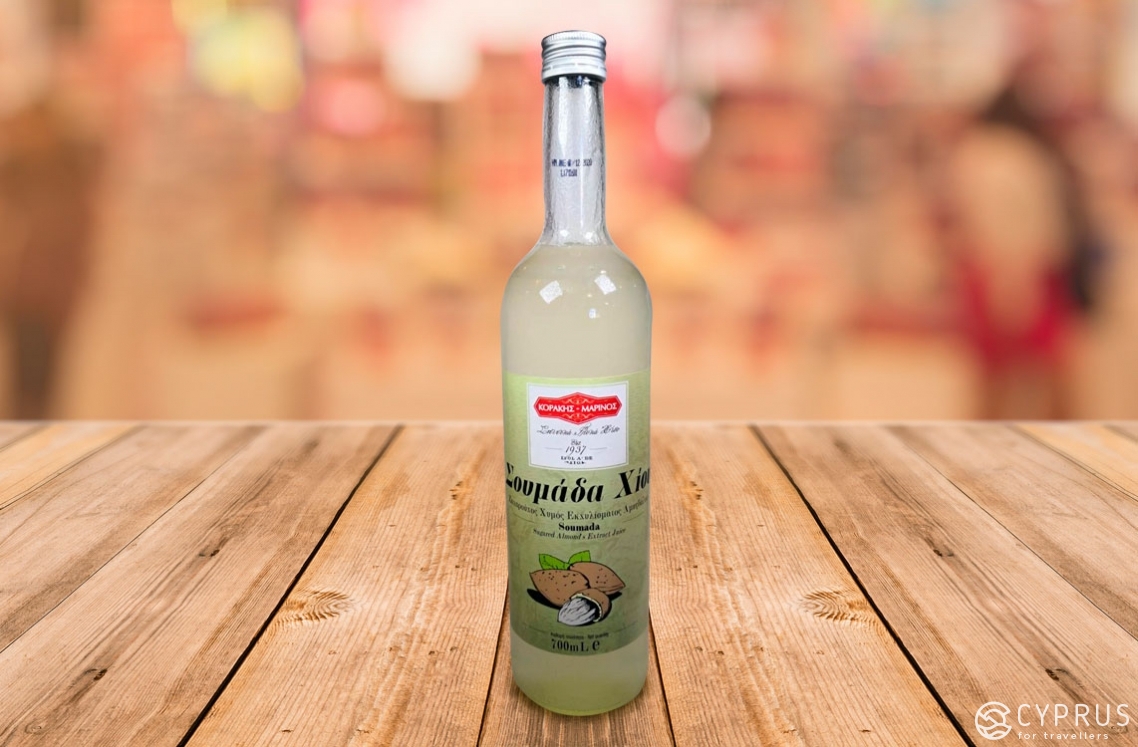
Aside from drinking freshly-squeezed juices, the vast array of manufactured sorts and fresh farm milk when staying on the island, it is definitely worth trying the sour dairy products.
Airani — a drink based on fermented milk with the addition of water, dried mint and salt (it is also a version of “ayrana” [5]), a beverage which came from Turkey, according to reliable sources, is well known to many people,). While this yoghurt drink improves digestion, it is no coincidence that salt is also added, as not only does it effectively quench your thirst, but also helps the drink to be stored for longer.
You will immediately notice its memorable, sourish, slightly salty and refreshing taste. Airani is made from the purest ingredients, without any additives or preservatives. Like in past decades, manufacturers use only natural yoghurt, drinking water, salt and finely chopped mint leaves.
How to serve: simply chill the airani, shake the bottle well and pour into glasses, serve on a hot day.
Another popular, sour dairy drink is produced in Cyprus, which is very popular in many countries of the world.
Kefir — a beverage with varying fat content, based on goat's milk and kefir culture, is produced on the island in 0.5-litre plastic bottles. Besides, more than the standard classic taste is available today: Cypriot producers have added flavours to their product range using a combination of various fruits, berries and even ... oats.
All kinds of smoothies, “eternal” mojitos and teas (black, but more often green or herbal) served with ice, are very popular in hot weather — just like in many other countries across the world.
And, nevertheless, the various herbs and drinks here, proudly bearing the name tea ... are very healthy. They sometimes strike you with their unusual combination of flavours, and have a substantial effect, even on those of us who have been accustomed to them since our early years. These fragrant concoctions bring us strength and warmth after a whole day spent with friends outside.
Teas
Aside from the common types of herbal and Phyto-teas in general, for instance, hibiscus, with chamomile and lavender, ginger, mint and lemon ... Cypriot shops can offer unique blends including sage, anise, verbena, calendula, rose, elderberry and even nettle.
They can also be easily found both in supermarkets and in any village or market, where they can be purchased in dry packet form. You are then free to create your own mixtures
based on the ingredient properties.
Alternatively, you can visit specialised places: one of them, for instance, is a botanical garden with its own plant for producing teas, extracts and other natural, very healthy plant-based products.
We are talking about CyHerbia Garden in Avgorou.
Visit here with your whole family and bring your friends along: entertaining and educational events are held continuously in the garden, and you can learn a lot of exciting things.
Amongst the local plants and flowers, it is worth mentioning the rose ... there are a great many of them here. Some of the varieties, alongside their beauty and scent, will give you a little something for your health.
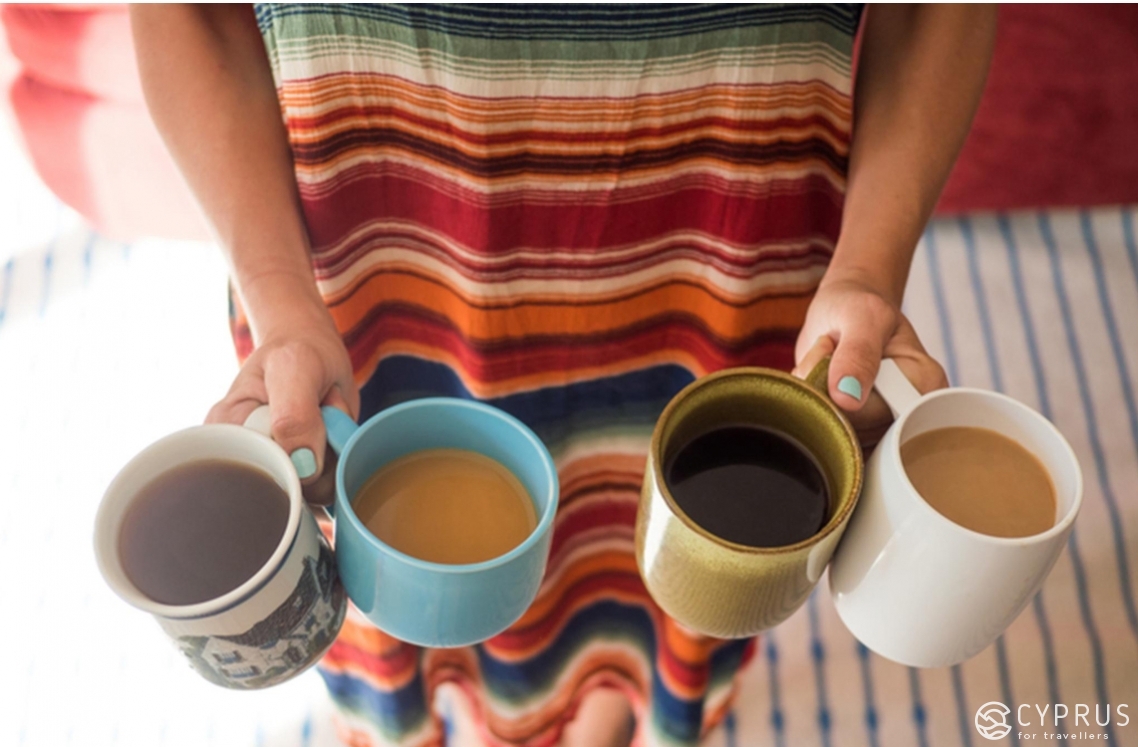
Rose Water (produced since the Antiquity from the Damask rose) — additives from it are parts of cocktails, beverages, desserts; it is used to make liqueurs and ice cream… not to mention its unique cosmetic applications.
It is even drunk in the form of a beverage called “triandafilo” (or simply “rose cordial” — with cold milk or simply diluted with cool water.
A general assortment rose water is manufactured in Cyprus on an industrial scale, under the brands “Amalia”, “Parpis” and “Mavroudes”, meaning that rose water can be bought with ease in practically any supermarket.
The following syrups and extracts (sold in 250 ml, 400 ml and 720 ml bottles) are intended for dilution in water, to make various cocktails, as well as any other refreshing or warming drink: Orange Squash, Lemon Cordial, Banana Cordial, Blackcurrant Cordial, Almond Cordial (Soumada), Carob Syrup, Grape Syrup. Along with these listed, you will definitely find Rose Cordial and Pink Rose Cordial.
For more details, please see here.
As you can see, there are very many healthy plants and other products which Cypriots have long been adept at using to skilfully fashion all kinds of drinks. And yet, hardly anything in Cyprus can compare with the passion that its people display for coffee.
Carrying on…
Carob (the fruit of the Carob tree)
Processed by two factories in Limassol, the pods of the carob tree are one of the most unique in terms of the benefit they provide. 90% of the total production volume is exported in the form of whole pods, grounded powder and valuable seeds to extract the gum inside (the E410 food additive — an emulsifier and thickening agent), as well as to produce potable alcohol.
A small amount of the carob harvest is sold to small local producers who use the pods, as well as the syrup, powder, pasteli and carob-based chocolate, as raw materials to make various dishes (especially desserts).
In 2005-2006, export volumes took a sharp fall for the first time, as carob trees were being felled to cultivate arable land. Another reason for the decline was the current owners' lack of desire to harvest their crops. After all, as it used to be, you have to spend a lot of time and effort on collecting them. Nevertheless, the demand for carob remains high, and the quality of carob products is still highly rated.
Members of the Cypriot produce market now have the task of promoting and popularising carob products, as an essential, irreplaceable component in the healthy and balanced diet of modern man.
“Karupomelo” Syrup from Carob
You will be making the right choice if you decide to include this completely natural syrup in your diet. To obtain it, manufacturers grind the "horns" to make the syrup, boiling off the treated raw materials in water. The extract is then boiled in a large cauldron (called a “harzhin” in the Cypriot dialect of the Greek language) for roughly 4 hours with constant stirring, until most of the water has evaporated, leaving a thick and sweet syrup that needs to be cooled before being bottled for sale.
Farmers of the past, before they began to work the fields in the early morning, would dissolve carob tree syrup in cold water and use it as an invigorating energy drink.
Moreover, carob powder is nowadays an excellent dietary substitute for cocoa and coffee. It can be added to both milkshakes and other drinks ... or mixed with extracts of sour orange, almond, vanilla and hazelnut.
One of the most critical characteristics of carob syrup is its ability to preserve all its useful properties for many years without any alterations.
Carob is a prevalent ingredient in many Cypriot desserts and baked goods:
- Carob cakes,
- Fondant with a carob or date filling,
- Carob Pancakes,
- Pumpkin Pie with Carob,
- You can also make something vegan with it: vegan carob brownies.
In winter weather, after a long stroll in the fresh air, the traditional drink of carob with milk and cinnamon will do a pretty good job of warming you up and giving you a rush of energy.

The Cult of Coffee
Like in many southern and eastern countries — and now, evidently, in most places across the planet — coffee is one of the leading drinks in the diet of a modern man. It is also an essential ingredient in many other compound drinks (and even desserts) present in a Cypriot’s diet, from morning to night.
On a separate note, Cypriot coffee is drunk on the island by everyone, everywhere, and at all times, served in small cups with a glass of cold water.
This type of coffee is unique and differs from what is drunk in the countries of Europe. Brazilian coffee beans are used as the raw material to prepare the drink. The coffee is brewed in batches in small copper coffee makers (in Russia, for instance, they are known as “Turks”), as in past eras.
Cypriot coffee is always served “black”, with no milk added.
You used to be able to drink authentic Cypriot coffee outside of your home, either in a restaurant or “cafenio”, which was long considered a conversation spot and entire social institution purely for males.
Nowadays, this rule is maintained, by and large, only in small villages, where all the men gather in Spartan cafenios to discuss important issues and exchange community news. The elderly males can also pass on their experiences to the younger men.

Traditional coffee can be ordered in three variations: “sketo” (without sugar), “metrio” (one teaspoon of sugar) or “gliko” (made with two teaspoons of sugar).
It is better to drink coffee at a leisurely pace and in small sips. The coffee is never mixed so that the thick layer of coffee grounds doesn’t rise from the bottom.
Cypriot coffee is an inherent part of the island’s so-called “Coffee House Culture", and the preparation of this potent drink requires a particular level of mastery and skill!
Shall we try to brew "cypriacos" on our own?
So, you ought to take natural finely ground coffee at the following ratio: a full teaspoon for one cup. If using a Turkish pot, fill it with one or two cups of water beforehand (depending on how many batches you’re brewing).
Pour in the coffee and add sugar if you wish (see above for how much). Put on a moderate heat and mix.
This mixture is then brewed in a small Turkish pot with a long handle known as a "briki" (they are also electrical), which can be found in practically any Cypriot household.
Whether you succeed actually depends on your level of expertise: you need to remove the coffee from the heat at the opportune moment. This exciting “moment of truth” comes when a uniform layer of foam, known as “kaymaki”, appears on the coffee’s surface.
The Turkish coffee pot is immediately removed from the heat, and the drink is carefully poured into cups.
Coffee is often served with “kurabedes” cookies, with dry, seeded bread (koulouri).
There are numerous videos on YouTube which cover this topic.
By the way, I want to share a secret with you: Cypriots really (incredibly so) love to banter with their foreign friends’ wives — obeying that hospitable impulse within, they treat their Cypriot guests, along with their beloved spouse, to a fragrant cup of cypriaco.
So, ladies, if you are not sure of your skill (repeatedly tested on Cypriot friends and well-disposed relatives) — you’re better to leave this be! Otherwise your unlucky opus, albeit coming from the heart, will become the laughing stock of the men for a long while. After all, many Cypriots are simply proud of their innate ability to make splendid coffee, which, in their eyes, elevates them to an unattainable height when compared to foreigners.
This is something you can still encounter here, even amongst the youngest of them!
Aside from “cypriaco” and mochas, Cypriots are well known for their love of frappes (and several other light caffeine drinks and cocktails with milk added: latte, cappuccino, espresso con panna, torre).
Frappe: What’s Behind the Name ... Or Another, "National" Drink of the Greeks From Both Countries
The coffee drink frappe (in Greek φραπές, frapés) with a characteristic foam “hat”, is made from instant coffee, water and sugar.
The story of the frappe tells of how the drink was accidentally invented in Thessaloniki in 1957 by Dimitris Vakondios, one of the workers at a Nescafe coffee shop. Despite the drink being of Greek origin, it was given a French name meaning "chilled in crushed ice."
Be that as is may, various cold coffee drinks and cocktails under the generic name “café frappé (à laplace)” were historically documented as far back as the 19th century. At the same time, some of them are said to have resembled “slush” in their consistency, while other types were, mainly, just cold coffee.
The Greek version actually appeared during the International Fair in Greece, where Yannis Dritzas, a Nestlé representative, was presenting a new children’s food product: a chocolate drink made almost instantly after mixing with milk and shaking well.
At that time, another employee involved in the fair, our “acquaintance” D. Vakondios, was at a loss for how to drink his usual instant coffee during his break, but he couldn’t find any hot water. So, after deciding to risk it, he dissolved the coffee powder in cold water, put the solution in a shaker with some ice cubes and gave it a good shake. And voila!
Frappes in Greece have three flavour variations (according to the degree of sweetness; with or without milk). It’s the same as with the cypriaco: a sweet frappe is a glykоs; a frappe of average sweetness — a metrios; and a completely sugar-free frappe is similar to a sketos.
They're sometimes served with milk instead of water (except for a small amount, which is used to whip the foam. This variation is often encountered in Cyprus.
You can also have frappes with added liqueurs (Kahlúa, Baileys Irish Cream, etc.). Some restaurants add a scoop of vanilla ice cream to their frappe instead of milk.
Would you like to have a go at making a real frappe?
It’s not complicated. For one glass, you’ll need:
- A shaker or a hand mixer (we affectionately call it a “frapper”),
- 1-2 teaspoons of instant coffee (get the legendary Nestle to make for a pure “experiment”),
- Half a glass of cold drinking water,
- Sugar and milk (fresh or concentrated) to your taste.
Method:
Put the coffee powder in, sprinkle sugar and top up with a little (roughly a 1/3 of the total) water. Whip the contents of your glass until you get a tall, fluffy layer of foam.
Now, gently top up the glass with the remaining water and add milk. Don’t mix them!
Serve with ice cubes if you wish, and, of course, don’t forget about the straw!
Although the frappe is, nowadays, associated with the Greek version of the instant coffee-based drink, in recent years, foreign tourists visiting Cyprus and Greece have adopted the frappe into their diet, now enjoying it in their own countries ... where the drink has specific differences.
It is said that in Bulgaria, Coca-Cola is sometimes used instead of water. In Denmark, for instance, water is much more often substituted for chilled milk; and in Serbia, they prefer to make a frappe with ice cream, adding whipped cream on top.

Frappe + Cappuccino: The Story of Coffee Continues
In the United States of America, however, “frappe” has two meanings: one — a thick milkshake “frapp"; the other — albeit with the same ingredients as the first — has nothing to do with the Greek original.
And so, the entrepreneurial Americans once went a step further ... Coffee Connection, a coffee shop in Boston (Massachusetts), began adding coffee to their standard milkshake. The drink was called a "frappuccino." Starbucks later bought the brand and the coffee house. In keeping with local tradition, Starbucks coffee shops in Greece and Cyprus offer guests both the American frappuccino and the Greek frappe.
In Cyprus, it is not only customary to order frappes from a cafe or buy them from kiosks at any time of the day, almost all year round — many often make them at home, for themselves and guests. The Nescafe brand is most commonly used, with the addition of either natural or concentrated milk. Ice water is added, and the mixture is then whipped with a mixer until a tall foam is obtained. Sometimes, in addition to a straw, ice cubes are also placed in tall glasses.
Like the superb drinking water from the Troodos mountain springs, coffee, in all its variations, is worth trying in the Cypriot style: with all kinds of desserts and, first and foremost, fruits and other products (!) boiled in sugar syrup.
Most of the lunch feasts in Cyprus actually end with these “gliko-tou-koutaliou” or “sweet spoons”.
These delicacies are widely produced from all kinds of fruits, vegetables and even nuts. Amongst the local favourites, there is the walnut, quince fruits, kumquats, bergamot, figs, watermelon and cherries! Indulge yourselves!
Well, that’s enough information and secrets for today…
For fans of Cypriot cuisine — its dishes and drinks — aside from our site (see here and here) these resources, some of which have authentic cooking recipes and serving methods, will come in handy: www.visitcyprus.com, www.thespruceeats.com.
This isn’t goodbye for long.
Until next time!

[1] But in 1910, this "green fairy", as European artists and intellectuals named it in the late 19th century, was banned for sale for almost 100 years. There were several reasons for this: including the presence of thujone, which was then considered to be capable of causing intense hallucinations and bouts of rage. Nevertheless, in 2011, absinthe returned to the shelves again in France.
[2] One of the most important ingredients in absinthe (70-75%) is the extract of bitter wormwood. In fact, the drink appeared in Switzerland, in 1792, as the result of a distillation experiment by the Enrio sisters, who were local herbalists. It was named “Bon Extrait d'Absinthe” and sold initially as a medicinal mixture. Aside from wormwood, absinthe contained anise, chamomile, coriander, lemon balm and others.
[3] Resination of white wine is officially permitted in Greece only: Aleppo pine resin (10 g per 1 litre) is used exclusively in the manufacturing process.
[4] For more original Cypriot liqueur recipes, see here: www.filfar.com.
[5] As Wikipedia says: “Airan is still very popular in Turkey, Iran, Iraq, Afghanistan, Armenia and Azerbaijan, the countries of Central Asia, the North Caucasus, the Balkans, and also the countries of the Middle East, especially in Lebanon and Syria. A similar drink is produced and drunk in India (the so-called “lassi”)”. Taken from www.en.wikipedia.org.



